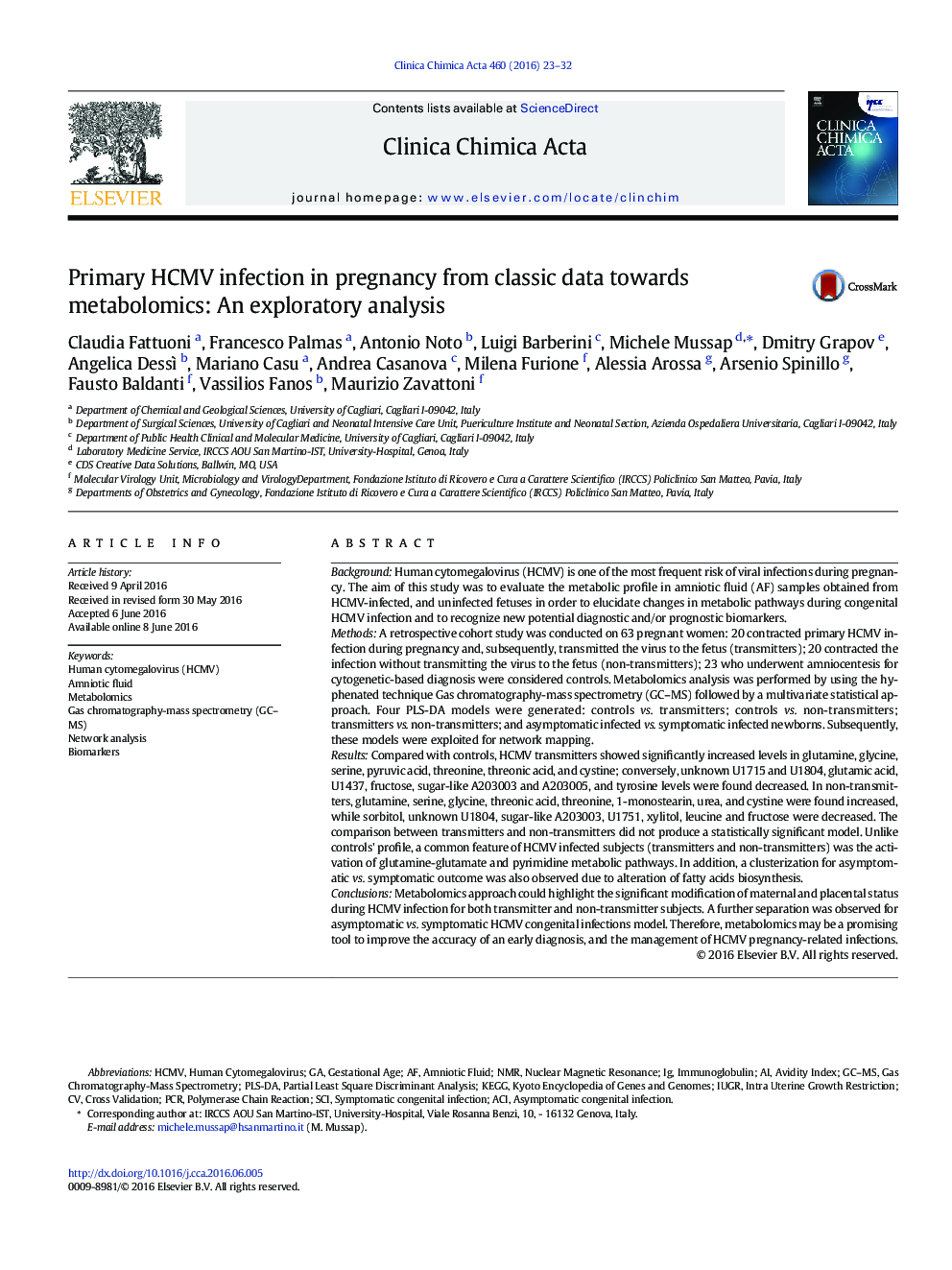| کد مقاله | کد نشریه | سال انتشار | مقاله انگلیسی | نسخه تمام متن |
|---|---|---|---|---|
| 1965026 | 1538639 | 2016 | 10 صفحه PDF | دانلود رایگان |

• The risk of HCMV vertical transmission leads to invasive prenatal investigations
• Around 8% of newborns HCMV negative before birth may be congenitally infected
• When PCR is negative, fetal infection cannot be definitively ruled out
• Fructose and sugar-like compound A203003 were less abundant in HCMV infected women
• The glutamine-glutamate pathway is mainly involved in HCMV infected women
• Another involved pathway in prenatal HCMV infections is pyrimidine biosynthesis
• The influence of fetal infection on AF is masked by the mother’s metabolic changes
• Metabolomics recognizes HCMV fetuses with no ultrasound pathological evidence
BackgroundHuman cytomegalovirus (HCMV) is one of the most frequent risk of viral infections during pregnancy. The aim of this study was to evaluate the metabolic profile in amniotic fluid (AF) samples obtained from HCMV-infected, and uninfected fetuses in order to elucidate changes in metabolic pathways during congenital HCMV infection and to recognize new potential diagnostic and/or prognostic biomarkers.MethodsA retrospective cohort study was conducted on 63 pregnant women: 20 contracted primary HCMV infection during pregnancy and, subsequently, transmitted the virus to the fetus (transmitters); 20 contracted the infection without transmitting the virus to the fetus (non-transmitters); 23 who underwent amniocentesis for cytogenetic-based diagnosis were considered controls. Metabolomics analysis was performed by using the hyphenated technique Gas chromatography-mass spectrometry (GC–MS) followed by a multivariate statistical approach. Four PLS-DA models were generated: controls vs. transmitters; controls vs. non-transmitters; transmitters vs. non-transmitters; and asymptomatic infected vs. symptomatic infected newborns. Subsequently, these models were exploited for network mapping.ResultsCompared with controls, HCMV transmitters showed significantly increased levels in glutamine, glycine, serine, pyruvic acid, threonine, threonic acid, and cystine; conversely, unknown U1715 and U1804, glutamic acid, U1437, fructose, sugar-like A203003 and A203005, and tyrosine levels were found decreased. In non-transmitters, glutamine, serine, glycine, threonic acid, threonine, 1-monostearin, urea, and cystine were found increased, while sorbitol, unknown U1804, sugar-like A203003, U1751, xylitol, leucine and fructose were decreased. The comparison between transmitters and non-transmitters did not produce a statistically significant model. Unlike controls' profile, a common feature of HCMV infected subjects (transmitters and non-transmitters) was the activation of glutamine-glutamate and pyrimidine metabolic pathways. In addition, a clusterization for asymptomatic vs. symptomatic outcome was also observed due to alteration of fatty acids biosynthesis.ConclusionsMetabolomics approach could highlight the significant modification of maternal and placental status during HCMV infection for both transmitter and non-transmitter subjects. A further separation was observed for asymptomatic vs. symptomatic HCMV congenital infections model. Therefore, metabolomics may be a promising tool to improve the accuracy of an early diagnosis, and the management of HCMV pregnancy-related infections.
Journal: Clinica Chimica Acta - Volume 460, 1 September 2016, Pages 23–32